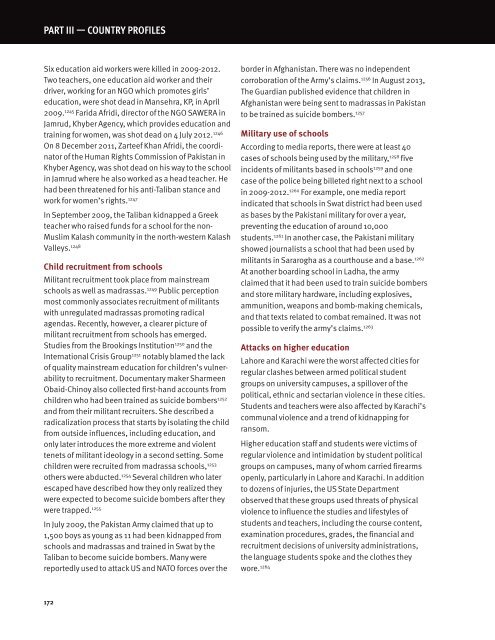Create successful ePaper yourself
Turn your PDF publications into a flip-book with our unique Google optimized e-Paper software.
PART III — COUNTRY PROFILeS<br />
Six education aid workers were killed in 2009-2012.<br />
Two teachers, one education aid worker and their<br />
driver, working for an NGO which promotes girls’<br />
education, were shot dead in Mansehra, KP, in April<br />
2009. 1245 Farida Afridi, director of the NGO SAWERA in<br />
Jamrud, Khyber Agency, which provides education and<br />
training for women, was shot dead on 4 July 2012. 1246<br />
On 8 December 2011, Zarteef Khan Afridi, the coordinator<br />
of the Human Rights Commission of Pakistan in<br />
Khyber Agency, was shot dead on his way to the school<br />
in Jamrud where he also worked as a head teacher. He<br />
had been threatened for his anti-Taliban stance and<br />
work for women’s rights. 1247<br />
In September 2009, the Taliban kidnapped a Greek<br />
teacher who raised funds for a school for the non-<br />
Muslim Kalash community in the north-western Kalash<br />
Valleys. 1248<br />
Child recruitment from schools<br />
Militant recruitment took place from mainstream<br />
schools as well as madrassas. 1249 Public perception<br />
most commonly associates recruitment of militants<br />
with unregulated madrassas promoting radical<br />
agendas. Recently, however, a clearer picture of<br />
militant recruitment from schools has emerged.<br />
Studies from the Brookings Institution 1250 and the<br />
International Crisis Group 1251 notably blamed the lack<br />
of quality mainstream education for children’s vulnerability<br />
to recruitment. Documentary maker Sharmeen<br />
Obaid-Chinoy also collected first-hand accounts from<br />
children who had been trained as suicide bombers 1252<br />
and from their militant recruiters. She described a<br />
radicalization process that starts by isolating the child<br />
from outside influences, including education, and<br />
only later introduces the more extreme and violent<br />
tenets of militant ideology in a second setting. Some<br />
children were recruited from madrassa schools, 1253<br />
others were abducted. 1254 Several children who later<br />
escaped have described how they only realized they<br />
were expected to become suicide bombers after they<br />
were trapped. 1255<br />
In July 2009, the Pakistan Army claimed that up to<br />
1,500 boys as young as 11 had been kidnapped from<br />
schools and madrassas and trained in Swat by the<br />
Taliban to become suicide bombers. Many were<br />
reportedly used to attack US and NATO forces over the<br />
border in Afghanistan. There was no independent<br />
corroboration of the Army’s claims. 1256 In August 2013,<br />
The Guardian published evidence that children in<br />
Afghanistan were being sent to madrassas in Pakistan<br />
to be trained as suicide bombers. 1257<br />
Military use of schools<br />
According to media reports, there were at least 40<br />
cases of schools being used by the military, 1258 five<br />
incidents of militants based in schools 1259 and one<br />
case of the police being billeted right next to a school<br />
in 2009-2012. 1260 For example, one media report<br />
indicated that schools in Swat district had been used<br />
as bases by the Pakistani military for over a year,<br />
preventing the education of around 10,000<br />
students. 1261 In another case, the Pakistani military<br />
showed journalists a school that had been used by<br />
militants in Sararogha as a courthouse and a base. 1262<br />
At another boarding school in Ladha, the army<br />
claimed that it had been used to train suicide bombers<br />
and store military hardware, including explosives,<br />
ammunition, weapons and bomb-making chemicals,<br />
and that texts related to combat remained. It was not<br />
possible to verify the army’s claims. 1263<br />
Attacks on higher education<br />
Lahore and Karachi were the worst affected cities for<br />
regular clashes between armed political student<br />
groups on university campuses, a spillover of the<br />
political, ethnic and sectarian violence in these cities.<br />
Students and teachers were also affected by Karachi’s<br />
communal violence and a trend of kidnapping for<br />
ransom.<br />
Higher education staff and students were victims of<br />
regular violence and intimidation by student political<br />
groups on campuses, many of whom carried firearms<br />
openly, particularly in Lahore and Karachi. In addition<br />
to dozens of injuries, the US State Department<br />
observed that these groups used threats of physical<br />
violence to influence the studies and lifestyles of<br />
students and teachers, including the course content,<br />
examination procedures, grades, the financial and<br />
recruitment decisions of university administrations,<br />
the language students spoke and the clothes they<br />
wore. 1264<br />
172


